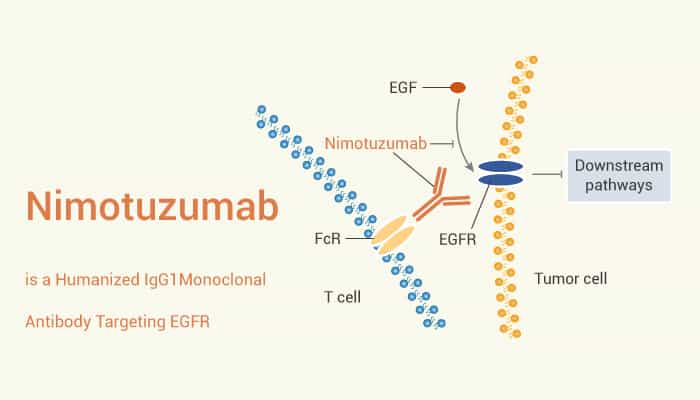The epidermal growth factor receptor (EGFR) is a transmembrane protein. The dimerization of EGFR stimulates the activity of intracellular protein tyrosine kinase. Therefore, several tyrosine (y) residues in the C-terminal domain of EGFR undergo autophosphorylation. These include y992, y1045, y1068, y1148, and y1173, as shown in the adjacent chart. Specifically, this autophosphorylation triggers downstream activation and signal transduction of several other proteins. Moreover, they are relevant to phosphorylated tyrosine through their own phosphorylated tyrosine binding SH2 domain. Besides, EGFR is a receptor tyrosine kinase, which can dimerize, autocross-phosphorylate, and initiate downstream signal cascade. Furthermore, EGFR is essential to control the growth and survival of epithelial cells. Overexpression or abnormal activation of EGFR is relevant to tumor progression and treatment resistance in a variety of cancer types. Meanwhile, EGFR tyrosine kinase inhibitors (TKIs) are the first-line treatment for NSCLC.
At present, EGFR inhibitors include small molecules targeting its ATP binding pocket and monoclonal antibodies targeting its ligand-binding domain. Nonetheless, these methods are focused on inhibiting EGFR kinase activity or inducing antibody and complement-mediated cytotoxicity. Additionally, EGFR targeted antibody is mainly used in the treatment of advanced colorectal cancer and head and neck cancer. Here, we will introduce a humanized IgG1 monoclonal antibody targeting EGFR, Nimotuzumab.

Nimotuzumab is a Humanized IgG1 Monoclonal Antibody Targeting EGFR.
At first, Nimotuzumab is a humanized IgG1 monoclonal antibody targeting EGFR with a KD of 0.21 nM. Interestingly, Nimotuzumab is directed against the extracellular domain of the EGFR blocking the binding to its ligands. Importantly, Nimotuzumab, a strong antitumor drug, is cytolytic on target tumors. Particularly, Nimotuzumab causes antibody-dependent cell-mediated cytotoxicity (ADCC) and complement-dependent cytotoxicity (CDC).
Secondly, Nimotuzumab with 10 μg/mL for 24 hours induces significant downregulation of CD16 on NK cells. Obviously, Nimotuzumab induces the upregulation of PD-L1 molecule on DCs when co-cultured with the NK: DC: HNSCC cells. The intrinsic properties of Nimotuzumab requires bivalent binding for stable attachment to cellular surface. The binding is with both antibody arms to two targets simultaneously. By the way, this leads to Nimotuzumab selectively binding to cells that express moderate to high EGFR levels.
All in all, Nimotuzumab is a humanized IgG1 monoclonal antibody targeting EGFR.
References:
Zaima Mazorra, et al. Front Pharmacol. 2017 Jun 19;8:382.